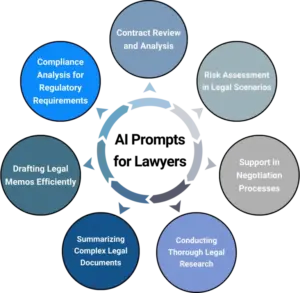Imagine embarking on a road trip without a map or GPS. You might get to your destination, but the journey would be fraught with uncertainty, wrong turns, and delays. Similarly, entering into a business agreement without a comprehensive contract review can lead to unforeseen risks, liabilities, and disputes.
Review contracts to make sure all obligations are met. It helps to spot any potential risks or liabilities. It helps clarify the contract, preventing misunderstandings and ensuring that the language, terms, and conditions are fair and acceptable. This thorough review makes negotiations and agreements go more smoothly, laying the groundwork for a successful business relationship.
By doing a full review, legal teams can avoid unnecessary risks and ensure the contract follows the guidelines. Let’s explore more in this blog.
Key Steps in the Contract Review Checklist

Just like a pilot goes through a pre-flight checklist to ensure safety, a legal team must follow a contract review checklist to ensure no detail is overlooked. This systematic approach helps in identifying potential issues early and addressing them proactively.
Here are the key steps involved in a contract review checklist:
- Initial Read-Through: Start with a high-level overview to understand the context and main points of the contract. This helps in understanding the overall purpose and layout.
- Detailed Clause Review: Review each clause carefully to ensure they are clear, easy to understand, and legally correct. Check for common clauses and confirm that they are suitable for the contract.
- Cross-Referencing: Compare the contract with relevant laws, regulations, and internal policies to ensure it meets all requirements. This step helps to spot any legal or regulatory issues.
- Risk Identification: Identify any potential risks or liabilities related to the contract terms. Assess the impact of these risks and recommend ways to address them.
- Another Review: Have another legal counsel review the contract to catch any overlooked details and provide an additional perspective.
Each step is important for a thorough and effective contract review. Using a detailed checklist helps legal teams stay consistent and accurate. This protects the organization from potential disputes and liabilities.
Related Article: How To Accelerate Contract Review Process? Effective Guide
Essential Clauses in Contract Review
Termination Clauses: What to Look For

Termination clauses in a contract are like the emergency exits in a building—they provide a clear path out if things go wrong. These clauses are crucial in defining the conditions under which a contract can be ended and the obligations of each party upon termination and at the end of the deal.
Key points to consider in termination clauses:
- Conditions for Termination: Clearly specify the conditions or events that allow for the termination of the contract. These might include breaches of the contract, insolvency, or failure to meet performance standards.
- Notice Periods: Define the notice period needed for termination. This guarantees that the party ending the contract gives the other party enough time to prepare.
- Penalties and Fees: Specify any penalties or fees for ending the contract early. These terms help cover any losses the non-terminating party might face.
- Post-Termination Obligations: Define what each party must do when the contract ends, like settling any unpaid amounts.
- Dispute Resolution: Outline the dispute resolution mechanisms applicable post-termination to handle any arising conflicts smoothly.
Termination clauses need to be written carefully to protect everyone involved and offer a clear, fair, and legally sound way to end the agreement.
Related Article: What is a Termination Clause in Contracts? A Short Guide
Confidentiality Clauses: Protecting Information

Confidentiality clauses are the vaults that protect sensitive information within a contract. These clauses make sure that confidential information is protected and not shared inappropriately. This helps to maintain trust and integrity in the business relationship.
Essential elements of confidentiality clauses include:
- Definition of Confidential Information: Clearly define what constitutes confidential information. This typically includes proprietary data, trade secrets, business plans, and other sensitive information.
- Duration of Confidentiality: This outlines how long the confidentiality obligations last, which can continue even after the contract ends to protect ongoing interests.
- Permitted Disclosures: Identify when it is acceptable to share confidential information, such as with legal advisors or when required by law.
- Consequences of Breach: Outline what happens if there is a breach of confidentiality. It covers the potential outcomes and remedies, which may include damages, court orders, and other legal actions.
- Return or Destruction of Information: Specify the steps for returning or destroying confidential information when the contract ends.
By including strong confidentiality clauses, parties can safeguard their sensitive information and ensure it is only used for its intended purpose.
Related Article: Importance of Confidentiality Clause: Your Ultimate Guide
Renewal Clauses: Ensuring Continuity

Renewal clauses in a contract act as a safety net, ensuring the continuity of the entire agreement beyond its initial term. These clauses set up a structure for extending the contract and keeping the business relationship going.
Important aspects of renewal clauses:
- Automatic vs. Manual Renewal: Determine whether a contract renews automatically or requires manual renewal through mutual agreement. Automatic renewals ensure continuous coverage without interruptions, while manual renewals provide the opportunity to renegotiate terms before renewal.
- Notice Period for Non-Renewal: Clearly state the notice period needed to prevent automatic renewal. This gives all parties enough time to make informed decisions.
- Conditions for Renewal: List any requirements that need to be met for the contract to be renewed. This could include specific performance goals or financial targets.
- Changes in Terms: Describe any updates to terms or conditions when the contract is renewed. This could include changes to pricing, scope, or responsibilities.
- Renewal Fees: Include any costs related to renewing the contract, so both parties understand the financial impact.
Renewal clauses offer stability and predictability, helping parties plan for the future and keep a good business relationship.
Related Article: What is Contract Renewal? Ultimate Guide To Success
Indemnification Clauses: Managing Risks

Indemnification clauses are like insurance policies within a contract, protecting parties from potential losses and liabilities. These clauses set out who is responsible for certain risks and losses. They ensure that one party will compensate the other for specific damages or issues.
Key elements of indemnification clauses:
- Scope of Indemnification: Define what indemnification covers by specifying the types of losses and liabilities included. This may encompass damages, legal fees, and other related costs.
- Conditions for Indemnification: It describes when indemnification is applicable. This may include situations such as breaches of contract, negligence, or claims made by third parties.
- Limitations and Exclusions: This section outlines any restrictions or exceptions to the indemnification obligations. It helps manage expectations and clarify what liabilities are covered.
- Procedure for Claims: This outlines the steps for making indemnification claims, including the necessary notifications and deadlines.
- Impact on Liability: This explains how indemnification clauses affect overall liability and insurance coverage. It ensures that all parties are properly protected.
Indemnification clauses are important for managing risks and protecting parties from unexpected financial costs.
Related Article: Understanding Indemnification Clause: A Comprehensive Guide
Review Contract Effectively with a Timeline

Setting a Realistic Timeline for Review
Setting a realistic timeline for contract review is similar to planning a project. It’s important to allocate enough time and resources to ensure a thorough and accurate review. This means balancing the need for speed with the need for a detailed examination.
Key considerations for setting a realistic timeline:
- Factors Influencing Timeline: Identify factors that impact the timeline, such as the complexity of the contract, the availability of stakeholders, and any regulatory requirements.
- Allocating Sufficient Time: Make sure to set aside enough time for a detailed review to avoid rushed decisions that might lead to errors.
- Balancing Urgency and Accuracy: Find a balance between the need to complete the contract quickly and the need for a thorough and accurate review.
- Coordination with Stakeholders: Work with all relevant parties, including legal teams, business units, and external advisors, to ensure a smooth review process.
- Contingency Planning: Prepare for possible delays and have backup plans ready to address any unexpected issues.
By setting a realistic timeline, legal teams can conduct a thorough and effective review process, reducing risks and ensuring compliance.
Managing Turnaround Time Effectively
Managing turnaround time in contract review is key to keeping business moving forward without sacrificing thoroughness and accuracy. This involves setting clear deadlines and creating efficient workflows.
Here are some strategies for effective turnaround time management:
- Clear Deadlines and Milestones: Set specific deadlines and milestones for each step of the review process. This helps track progress and ensures that everything gets done on time.
- Efficient Workflow and Communication: Use an efficient workflow and keep communication clear within the legal team. This makes sure everyone is aligned and working towards the same goals.
- Utilizing Technology: Use technology to speed up the review process. This can include contract management software and AI tools to automate repetitive tasks.
- Prioritizing Critical Sections: Focus on reviewing the most important sections of the contract first, especially high-risk areas and key clauses.
- Monitoring Progress: Keep an eye on progress and adjust timelines as needed. This helps address any issues quickly and keeps the review on track.
By managing turnaround time effectively, legal teams can ensure a thorough review while meeting business needs.
Related Article: Contract Clause Library: Your Comprehensive Guide
Role of AI in Contract Review

How AI Can Streamline the Review Process
AI is revolutionizing contract review by offering tools that change how legal teams work. When AI is added to contract management systems, it can greatly improve efficiency and accuracy. Here’s how AI is making a difference:
- Automating Routine Tasks: AI handles repetitive tasks like sorting documents, identifying clauses, and inserting standard clauses. This saves time for legal professionals to focus on more complex issues.
- Reducing Errors: AI algorithms analyze contracts with great precision, lowering the chance of mistakes that can happen in manual reviews. This improves accuracy in spotting key terms and inconsistencies.
- Speeding Up the Review Process: AI quickly goes through large numbers of contracts to find and highlight important clauses, deadlines, and obligations, speeding up the review.
- Offering Insights: AI analyzes past contract data to find patterns, risks, and opportunities, providing valuable insights for better decision-making.
- Integrating with Existing Systems: AI tools work well with current contract management systems, enhancing their capabilities without needing to completely change existing processes.
Using AI in contract review makes the process more efficient and effective, leading to better decision-making and reduced risk.
What AI Tools are available for Contract Review?
AI tools designed for contract management offer a range of features that cater to various aspects of the contract lifecycle. These tools can significantly improve the efficiency and accuracy of contract management processes. Here’s a look at some of the key features:
- Document Analysis: AI tools can analyze and categorize contract documents with high precision, identifying key clauses, terms, and obligations.
- Risk Assessment: These tools assess potential risks associated with contract terms, providing alerts and recommendations to mitigate potential issues.
- Automated Workflows: AI tools automate processes such as document routing, approvals, and notifications, streamlining the overall review process.
- Integration Capabilities: Many AI tools integrate with existing systems such as CRM and ERP platforms, providing a unified view of contract data and improving overall efficiency.
- Advanced Search and Reporting: AI tools offer advanced search functionalities and generate comprehensive reports, facilitating better tracking and management of contract performance.
By leveraging AI tools, legal teams can enhance their contract management capabilities, making the process more efficient and accurate while gaining valuable insights into contract performance.
Related Article: Best Contract Management Software: Top 10 CLM in 2024
Creating a Contract Review Checklist Template for Contract Reviewers

Creating a Contract Review Checklist Template is crucial for making sure contract reviews are thorough and consistent. This checklist helps reviewers evaluate contracts in a structured way and keeps reviews uniform across different reviewers. Key components to include:
- Key Elements: Include basic items like the parties involved, contract terms, and main obligations. This ensures that all important parts are covered.
- Customization: Adjust the checklist for different contract types, such as service agreements, non-disclosure agreements (NDAs), or purchase contracts, to meet specific needs.
- Standardization: Use the same checklist for all reviews to keep the process consistent and make sure everyone follows the same steps and criteria.
- Updating and Maintenance: Regularly update the checklist to reflect changes in laws, regulations, and business practices. This keeps the checklist current and useful.
- Examples: Provide examples and tips for each checklist item to help reviewers understand what to look for and how to evaluate each part.
Using a contract review checklist template helps make the review process smoother. It ensures all necessary elements are checked, and reduces the risk of missing important details.
Related Article: Legal Playbook: Reasons Why Your Business Needs One
Essential Items in a Contract Review Checklist

A good contract review checklist should cover all important points to ensure a thorough review. Key items to include are:
- Basic Contract Information: Check that basic details, such as the parties involved, contract terms, and the contract’s purpose, are accurate. This makes sure all fundamental information is correct.
- Review of Key Terms and Clauses: Look at important terms and clauses, like payment terms, deliverables, and performance obligations. This helps spot any potential problems or inconsistencies.
- Identification of Potential Risks and Liabilities: Identify possible risks and liabilities related to the contract terms and see how they are managed. This helps in minimizing potential risks.
- Verification of Compliance with Laws and Regulations: Make sure the contract follows relevant laws, regulations, and company policies. This helps avoid legal and compliance issues.
- Final Approval and Sign-Off Procedures: Include steps for getting final approval and signatures from the necessary stakeholders. This ensures that all needed approvals are obtained before finalizing the contract.
By including these key points in a contract review checklist, legal teams can conduct a thorough and effective review, reducing the chance of disputes and compliance issues.
Related Article: AI-Powered Clause Library: Faster & Efficient Drafting
Addressing Dispute Resolution and Remedies

Common Dispute Resolution Clauses
Dispute resolution clauses are important for handling conflicts that might come up during a contract. These clauses lay out a clear way to resolve disputes and usually include:
- Types of Dispute Resolution Methods: Define the different methods available, such as arbitration, mediation, or litigation. Each method has its own steps and consequences, which should be clearly explained.
- Conditions for Using Each Method: Describe the situations that will lead to using each dispute resolution method, so everyone knows when and how disputes will be handled.
- Procedures for Starting Dispute Resolution: Explain the steps for starting the dispute resolution process, including how to give notice and any deadlines. This ensures that the process is followed properly.
- Costs and Fees: Include details about who will pay for the costs and fees related to resolving disputes, ensuring transparency and fairness.
- Effect on the Contract: Consider how the dispute resolution process might affect the overall contract and make sure it doesn’t weaken the contract’s effectiveness.
Having clear and detailed dispute resolution clauses helps manage conflicts effectively, keep business relationships positive, and ensure disputes are resolved fairly and systematically.
Remedies for Breach of Contract
Remedies for breach of contract help address violations of business contract terms and provide compensation for losses. It’s important to clearly outline these remedies so that everyone knows their rights and options:
- Types of Remedies Available: List the types of remedies, such as damages (including direct, consequential, and punitive damages), specific performance, injunctions, rescission, and restitution. Each type of remedy addresses different aspects of a breach.
- Conditions for Remedies: Describe the conditions that must be met for each remedy to apply, so everyone understands what is required to claim these remedies.
- Procedures for Claiming Remedies: Explain the steps and necessary documentation for claiming remedies.
- Limitations and Exclusions: Identify any limitations or exclusions, such as caps on damages or specific situations where certain remedies are not available.
- Impact on Future Relationships: Consider how remedies might affect future business relationships to ensure they do not damage ongoing partnerships.
Including detailed remedies for breach of contract helps protect all parties involved and provides a clear way to handle and resolve breaches.
Related Article: Master Contract Redlining: What is it and How to do It?
Common Pitfalls in Contract Review

Unnecessary Risks to Avoid in Contract Review
Avoiding unnecessary risks in contract review is key to protecting everyone’s interests. Here are some common pitfalls to watch out for:
- Overlooking Important Clauses and Terms: Make sure to thoroughly review and address all critical clauses, such as indemnification and termination.
- Failing to Spot and Address Potential Risks: Identify and manage potential risks in contract terms to prevent future problems.
- Relying Too Much on Standard Templates: While templates can be helpful, customize them for your specific needs rather than using them as-is.
- Inadequate Review by Experienced Legal Counsel: Have contracts reviewed by skilled legal professionals to catch potential issues and ensure legal compliance.
- Ignoring Jurisdiction-Specific Laws: Consider local laws and regulations to avoid legal complications and ensure compliance.
By avoiding these pitfalls, the legal department can ensure a more effective and thorough contract review process, minimizing the risk of disputes and compliance issues.
How to Identify and Correct Errors
Errors in contracts can cause serious issues and need to be addressed quickly. Here are some simple ways to identify and fix these errors:
- Common Errors in Contracts: Watch out for common mistakes like drafting errors, unclear terms, and inconsistencies. Knowing about these issues helps you find and fix them better.
- Techniques for Finding Errors: Use methods like careful proofreading, checking against related documents, and using AI tools to spot mistakes.
- Procedures for Fixing Contracts: Follow standard steps for fixing and updating contracts, such as documenting changes and getting the necessary approvals.
- Importance of Proofreading: Make sure to thoroughly proofread contracts to catch and correct errors before they are finalized.
- Role of Technology: Use technology and AI tools to help find mistakes and improve accuracy during the contract review process.
By using these techniques, legal teams can effectively find and fix errors, making sure contracts are accurate and reliable.
Related Article: Legal Playbook: Reasons Why Your Business Needs One
Conclusion
In conclusion, a thorough contract review is essential for ensuring that contract language aligns with the nature of the contract and meets all parties’ expectations. This process includes scrutinizing warranties, assessing contract renewal terms, and ensuring the clarity of wording and consistency throughout the document.
Proper review also involves addressing any revisions and verifying the accuracy of terms before signing. Leveraging tools like email for communication and updates can streamline the review process, ensuring that all aspects of the contract are meticulously handled.
By focusing on these elements, legal teams can prevent misunderstandings and ensure that agreements are both fair and legally sound.





